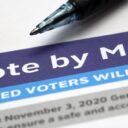In a recent survey, Gallup found that Americans still rate the Republican Party – 39% – less favorably than the Democratic Party – 46%. However, both parties’ favorability ratings are down from November 2012, just after the presidential election. The Democrats’ favorability rating dropped more, down from 51%, which was a post-election bump just after President Barack Obama won re-election. Even though Americans’ ratings of the Democratic Party clearly show that bump is over, their views of the GOP are the lowest since May of 2010.
A majority of Americans – 53% – have an unfavorable view of the Republican Party, which is pathetically up a bit from November, when it was 50%. Yet, the Democrats are not far behind, as 48% of Americans view the Democratic Party unfavorably, which is an increase from the 43% measured in November.
Not surprisingly, literally a fifth of American adults see both parties unfavorably, while just 12% – which is surprisingly high – view both parties favorably. Underscoring the polarization in American political discourse, 60% view one party favorably and the other unfavorably. In a recent survey released last week, Gallup found Americans have a historically low confidence in Congress. Ranking among the bottom of the institution confidence measurement was HMOs, labor unions and the Supreme Court.
Gallup Reports Dems Historically More Popular, but Both Parties Below Average
Historically, Gallup has found that the American public has viewed the Democratic Party more favorably than the GOP since Gallup first began to ask this question in 1992. The Democrats have an average favorability rating of 52%, while the GOP’s average is 46%, coincidentally (or maybe not) Democrats have enjoyed an average advantage in the electorate of +6. In this latest survey, both parties are clearly underperforming juxtaposed to their respective historical averages – which Gallup says is a trend that has been apparent to them for several years now.
The Republican Party’s favorable rating has historically hovered in the low 40’s to high 30’s since mid-2005. Not coincidentally, this is the period President George W. Bush’s disapproval ratings began to move above 50% as a result of the War in Iraq.
Democrats, on the other hand, have seen their high 2008-2009 favorable rating fall to a low of 41% in March of 2010, before it slowly climbed back up, although not to its earlier levels and it clearly did not help in November. Sadly, either party has been viewed favorably by a majority of Americans since 2009, with the brief exception of the Democrats’ post-election “victory bump” in 2012, when it reached 51% for the Democratic Party.
Even worse, Republicans last recorded a majority favorability rating among 51% of Americans after the start of President Bush’s second term, in February 2005.
Currently, the 7% “favorability advantage” that the Democratic Party now enjoys over the Republican Party is right on par with the average 6% gap observed by Gallup since 1992.
There have been certain periods when American held a much more positive view of one party than the other. It should be expected that these abnormalities would occur in times of specific political environments and events. Democrats held a 26-point favorability advantage over the Republicans, which is the largest gap measured by Gallup, in December of 1998. At the time it was the then-ongoing impeachment proceedings against the popular President Bill Clinton.
The same is true of the Democrats favorability advantage over Republicans after Democrats retook control of Congress in the 2006 midterms and then went on to capture the White House in 2008.
On the flip side, the Republicans’ largest advantages in favorable ratings over the Democratic Party have been far less extreme, as the highest advantage recorded was a 10% edge in February of 2005, just after Republican President Bush was re-elected and the Republicans controlled Congress. It will be interesting to see going forward if the GOP will maintain their likely voter edge, as although they have not measured as large of advantages of Democrats they have nonetheless been able to pull off wave elections.
Gallup Survey Key Findings & Implications
- Americans continue to view the Republican Party less favorably than the Democratic Party, but neither party musters a positive image among a majority of Americans. The Democrats’ current favorability lead over the Republicans is not unusual historically, and hardly assures a pending Democratic wave in 2014. Republicans had even lower favorability ratings in surveys shortly after the 2008 presidential election, but regained their footing over the ensuing two years and routed the Democrats in the 2010 congressional elections.
- More broadly speaking, these depressed favorability ratings appear to be a continuation of a longer trend that has seen Americans sour on the two parties. With the exception of one instance right after the November 2012 elections, neither party has had a majority favorable rating since August 2009, and the favorable ratings of the two parties are below their historical averages. Meanwhile, about a fifth of Americans disapprove of both parties.
- Even amid this backdrop, it is not clear that a new political party could coalesce the dissatisfied and credibly challenge the major parties. More likely, should these low political party favorable ratings continue, the result may be declining voter participation rates — as in the presidential contest of 2012, which had lower turnout rates than the presidential elections of 2004 and 2008.







